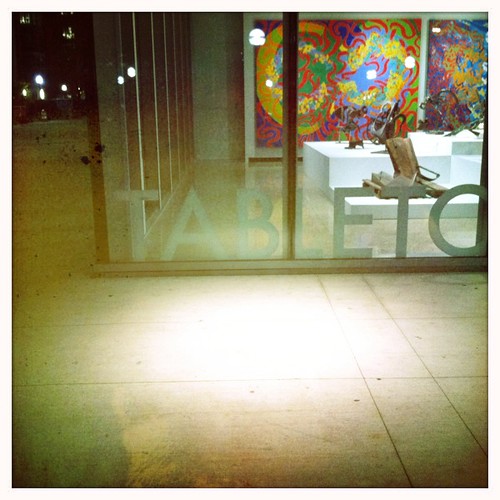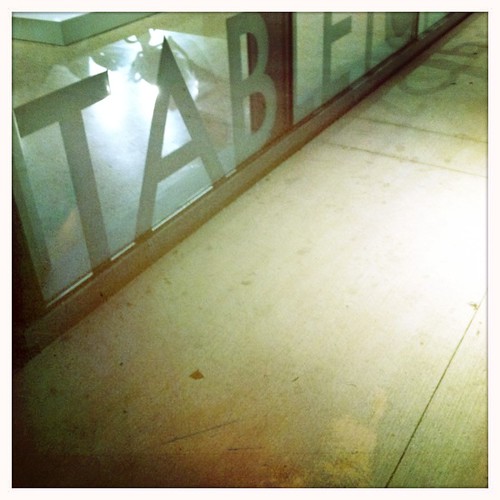 Amongst the hustle and bustle of a busy college life, it seems as though there’s hardly time to breathe. So, when the moment strikes and there’s a minute to spare, why not venture to the University of Michigan Museum of Art? Certain places on campus such as the art museum and graduate stacks provide the perfect temporary escape. Environments such as these enable students to loose themselves and to momentarily disconnect from the whirlwind of academics. The UMMA encourages students to engage in something cultural, but proves to be more energizing than mind draining. Who knows how many times a day students pass the art museum on their way to class, glance into the glass box that is The UMMA Projects, and wonder what in the world is in there. After a long day of back-to-back classes, a sudden calm awaits by simply wandering the gallery stalls and taking a few minutes sitting down, or rather standing around, Mark Di Suvero’s current exhibit: Tabletops.
Amongst the hustle and bustle of a busy college life, it seems as though there’s hardly time to breathe. So, when the moment strikes and there’s a minute to spare, why not venture to the University of Michigan Museum of Art? Certain places on campus such as the art museum and graduate stacks provide the perfect temporary escape. Environments such as these enable students to loose themselves and to momentarily disconnect from the whirlwind of academics. The UMMA encourages students to engage in something cultural, but proves to be more energizing than mind draining. Who knows how many times a day students pass the art museum on their way to class, glance into the glass box that is The UMMA Projects, and wonder what in the world is in there. After a long day of back-to-back classes, a sudden calm awaits by simply wandering the gallery stalls and taking a few minutes sitting down, or rather standing around, Mark Di Suvero’s current exhibit: Tabletops.
Perhaps Suvero’s work is unfamiliar, but chances are readers know more about the American artist than they imagine. The mammoth red-painted steel sculpture outside the art museum is in fact a Suvero sculpture, as is the smaller, rusted swing structure nestled between the new and old wings of the museum. Rumor has it, if you look at the red beams from any direction the word “art” appears. Similarly, many of the structures within the exhibit express hidden symbols.
In his youth, Suvero worked in construction but after a close encounter with a crippling injury, Suvero was unable to work construction and turned to welding. With time, Suvero became a skilled sculptor and his art became well known in the realm of Abstract Expressionism. Suvero’s work employees recycled materials and salvaged industrial metals, synonymous with public art. Surely many communities outside of Ann Arbor have noticed an increase in the number of modern art popping up around town.
Tabletops is a caprice of Suvero’s work, varying in year of creation and materials. Suvero’s pallet includes various materials such as steel, wood, titanium, and treated metals married together to create something unrecognizable. Suvero’s sculptures thoughtfully consider physics, music, balance, and play with shape, proportion, and movement. Perhaps the boldest works of Suvero’s artistic expression are the vibrant, large-scale, abstract paintings positioned on two of the four walls of the glass box. In the center of the gallery lies a multilevel platform with a multitude of sculptures, each displaying a unique arrangement of angles, amorphous shapes, lines, and curves. Many of the sculptures look antiquated, either tarnished with time or covered in rust. 
Some materials appear to be ‘found objects’ that Suvero discovered and morphed into something new. Certain facets of the metal structures are comprised of familiar objects like an old mechanical wheel or a rusted nail. Items such as the steel beams and rusted gears bring to mind the increasing number of abandoned buildings and factories close to home, such as the Packard Plant in Detroit. Historical landmarks such as these once housed the machinery and workers that built Industrial America. However, the nuts and bolts that once held our country together continue to crumble. Today, the architectural units America built itself around are relics, or ruins, of history standing still.
Tabletops is on exhibit at the University of Michigan Museum of Art until February 26th, allotting plenty of time to plan a visit or to stop by when it’s least expected. At some point between now and February make a promise to visit, break through the glass walls, and investigate. Most importantly, continue to search for hideouts on campus. Maybe you’ll love the UMMA, maybe you’ll hate it, but I promise you will appreciate the time you give yourself to consider it.

